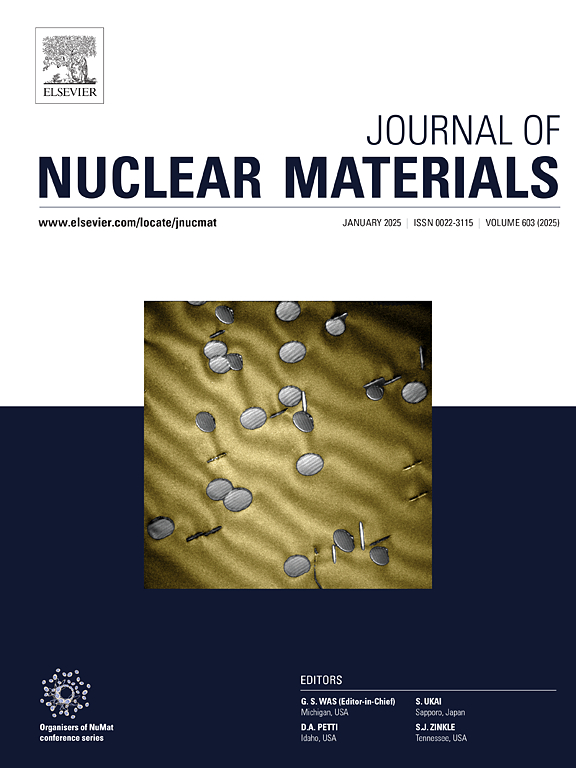三点弯曲CW-316试样的堆内应力松弛:实验与模型
IF 2.8
2区 工程技术
Q3 MATERIALS SCIENCE, MULTIDISCIPLINARY
引用次数: 0
摘要
冷加工316不锈钢的三点弯曲桩内应力松弛试验在混合光谱OSIRIS反应器中进行了表征,温度为330°C,最高达7 dpa。基于桩外相测量,确定了松驰动力学。实验设计允许研究从100mpa到600mpa的初始规定应力水平,并研究瞬态(主要)和稳态(次要)应力松弛。发现松弛动力学不受初始规定应力的影响,但取决于样品的冷加工水平。没有观察到孵育剂量,即使是在低初始应力下加载的样品。考虑到三点弯曲试样在弹塑性载荷域中存在的非均匀应力分布,采用有限元模型对实验结果进行了解释。线性应力相关蠕变定律,由两个代表瞬态和稳态蠕变的术语组成,可以很好地描述在所研究的应力范围内的实验松弛动力学。发现主要蠕变振幅参数依赖于冷加工水平,这与文献一致。稳态蠕变系数为0.96 10−6 MPa−1。与快堆报告值一致的Dpa−1是在冷加工水平上独立获得的。结果表明,在不均匀应力状态和残余应力进入试样的情况下,由挠度松弛比可以直接确定应力松弛比。本文章由计算机程序翻译,如有差异,请以英文原文为准。

In-reactor stress relaxation of 3-point bending CW-316 samples: Experiments and modelling
3-point bending in-pile stress relaxation tests of cold-worked 316 stainless steel have been characterised in the mixed-spectrum OSIRIS reactor up to 7 dpa at 330 °C. Relaxation kinetics were determined based on out of pile interphase measurements. The experimental design allows to study initial prescribed stress levels from 100 MPa up to 600 MPa and to investigate transient (primary) and steady-state (secondary) stress relaxation. Relaxation kinetics were found to be unaffected by initial prescribed stress but to depend on the cold work level of the samples. No incubation dose was observed, even for samples loaded at low initial stresses. Experimental results were interpreted using FE modelling to take into account the non-uniform stress distribution existing in 3-point bending samples loaded in the elasto-plastic domain. The linearly stress-dependent creep law, consisting of two terms representing transient and steady-state creep regimes, allows for a very good description of experimental relaxation kinetics all over the investigated stress range. The primary creep amplitude parameter was found to be dependent on the cold work level, which is consistent with literature. A steady state creep coefficient of 0.96 10−6 MPa−1.dpa−1 consistent with the values reported from fast reactors was obtained independently on the cold work level. Also it was shown that the stress relaxation ratio can be directly determined based on deflection relaxation ratio despite the non-uniform stress state and residual stresses into the samples.
求助全文
通过发布文献求助,成功后即可免费获取论文全文。
去求助
来源期刊

Journal of Nuclear Materials
工程技术-材料科学:综合
CiteScore
5.70
自引率
25.80%
发文量
601
审稿时长
63 days
期刊介绍:
The Journal of Nuclear Materials publishes high quality papers in materials research for nuclear applications, primarily fission reactors, fusion reactors, and similar environments including radiation areas of charged particle accelerators. Both original research and critical review papers covering experimental, theoretical, and computational aspects of either fundamental or applied nature are welcome.
The breadth of the field is such that a wide range of processes and properties in the field of materials science and engineering is of interest to the readership, spanning atom-scale processes, microstructures, thermodynamics, mechanical properties, physical properties, and corrosion, for example.
Topics covered by JNM
Fission reactor materials, including fuels, cladding, core structures, pressure vessels, coolant interactions with materials, moderator and control components, fission product behavior.
Materials aspects of the entire fuel cycle.
Materials aspects of the actinides and their compounds.
Performance of nuclear waste materials; materials aspects of the immobilization of wastes.
Fusion reactor materials, including first walls, blankets, insulators and magnets.
Neutron and charged particle radiation effects in materials, including defects, transmutations, microstructures, phase changes and macroscopic properties.
Interaction of plasmas, ion beams, electron beams and electromagnetic radiation with materials relevant to nuclear systems.
 求助内容:
求助内容: 应助结果提醒方式:
应助结果提醒方式:


